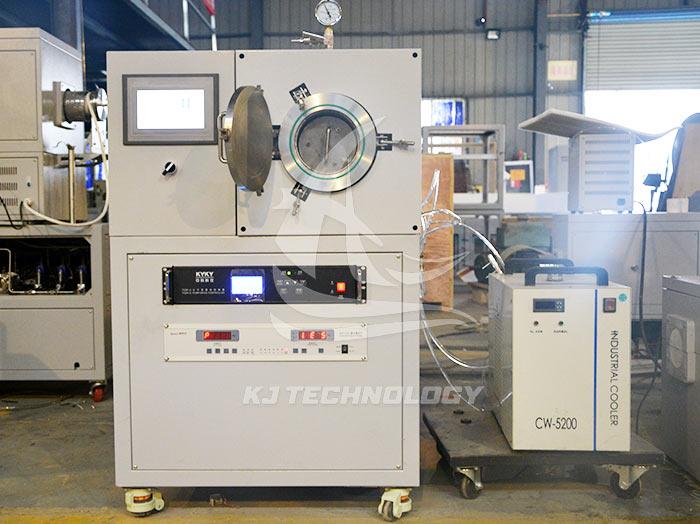What are the advantages of electric heating vacuum annealing furnace?
 11-12-2025 Author: KJ technology
11-12-2025 Author: KJ technology
The electric heating vacuum annealing furnace combines the efficient temperature control of electric heating with the isolation protection of vacuum environment, showing significant advantages in the field of material heat treatment, especially suitable for scenarios with high requirements for surface quality and performance stability. The following are its core advantages and specific application values:
1. Core advantages
a. Vacuum environment: isolate pollution and ensure material purity
Anti oxidation and decarburization: The vacuum degree can reach 1 × 10-3Pa or even lower, completely isolating active gases such as oxygen and nitrogen, avoiding surface oxidation or decarburization of metal materials (such as stainless steel and titanium alloys) at high temperatures, reducing the formation of oxide scale, and lowering subsequent pickling and polishing costs.
Preventing carbon pollution: For materials that are prone to carbon increase in a carbon containing atmosphere (such as certain high-temperature alloys), a vacuum environment can prevent the infiltration of carbon elements and maintain the stability of the material's chemical composition.
Application scenarios: Medical devices (such as surgical knives, implants), aerospace components, food equipment, and other fields that require extremely high surface cleanliness.
b. Precise temperature control: improve performance uniformity
High precision temperature control: Adopting a PID closed-loop control system, temperature fluctuations can be controlled within ± 0.75 ∘ C to ensure uniform and stable temperature of the material during annealing.
Multi stage program temperature control: supports independent temperature and time settings for heating, holding, cooling, and other stages to adapt to the process requirements of different materials (such as stainless steel annealing requiring segmented temperature control to eliminate stress).
Application value: Optimize grain structure, improve material toughness, corrosion resistance and other properties, reduce performance differences caused by uneven temperature.
c. Rapid temperature rise and fall: improve production efficiency
Efficient heating: Electric heating methods such as resistance wire and induction heating have a fast heating rate (up to 150 ° C/second), shortening the process cycle.
Rapid cooling: Equipped with an air-cooled or water-cooled system, the cooling rate is significant, avoiding thermal damage to materials due to prolonged exposure to high temperatures.
Typical case: Rapid Heat Treatment (RTP) technology can complete annealing within seconds and is suitable for scenarios such as semiconductor wafers and thin film materials that are sensitive to heat treatment time.
d. Energy conservation and environmental protection: reducing overall costs
High energy efficiency: Electric heating directly converts electrical energy into thermal energy, reducing heat loss and being more energy-efficient compared to gas stoves.
No exhaust emissions: The vacuum environment does not require combustion, avoiding the production of pollutants such as CO and NOx, which meets environmental protection requirements.
Reduce material loss: The anti oxidation and decarbonization properties reduce the formation of oxide scales and minimize raw material waste.
2. Process flexibility: Adapt to diverse needs
a. Support multiple material processing
Metal materials: stainless steel, titanium alloy, high-temperature alloy, aluminum alloy, etc., meet the annealing requirements of different materials by adjusting the temperature and vacuum degree.
Non metallic materials: ceramics, glass, etc. Vacuum environment can avoid reaction with gases at high temperatures and maintain stable material properties.
Composite materials: such as metal ceramic composite materials, vacuum annealing can reduce interfacial reactions and improve bonding strength.
b. Combining other processes to achieve integrated production
Vacuum brazing: directly brazing after annealing to avoid material exposure to air again and improve joint quality.
Bright quenching: Quenching is completed in a vacuum environment to maintain surface smoothness, suitable for decorative stainless steel products.
Carbonization/Nitriding: Combined with vacuum carburizing and nitriding processes, achieving a balance between surface hardening and core toughness.
3. Equipment stability and reliability
a. Long life design
High temperature resistant materials: The heating chamber is made of high-temperature resistant materials such as quartz and graphite, which can withstand temperatures above 1200 ℃ for a long time.
Vacuum system optimization: Molecular pumps, diffusion pumps, and other vacuum devices have long lifespans, short maintenance cycles, and reduced downtime risks.
Case: A vacuum annealing furnace used by a certain enterprise has been running continuously for 5 years without any faults, ensuring the stability of the production line.
b. Intelligent control system
Remote monitoring: Supports IoT connection, real-time monitoring of temperature, vacuum degree and other parameters, automatic alarm for abnormal situations.
Data recording: Automatically generate process curves and reports for quality traceability and process optimization.
Easy to operate: touch screen interface, preset process library, reducing operation difficulty and minimizing human error.
4. Industry application and efficiency improvement
a. Improve product yield
Case: A medical device manufacturer uses a vacuum annealing furnace to process 316L stainless steel surgical instruments. After annealing, the surface is free of oxidation and directly passes sterilization testing, resulting in an improved yield rate.
Benefit: Reduce scrap rate, lower rework costs, and shorten delivery cycles.
b. Extend the lifespan of equipment
Case: A certain aerospace company used a vacuum annealing furnace to treat titanium alloy components, which increased fatigue life by three times after stress relief and reduced replacement frequency.
Benefit: Reduce maintenance costs and improve equipment utilization.
c. Meet the demands of the high-end market
Case: A semiconductor manufacturer achieved non oxidation annealing of wafers through a vacuum annealing furnace, and the product performance reached the international advanced level, successfully entering the high-end market.
Benefit: Enhance brand competitiveness and attract high value-added customers.








